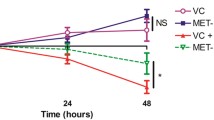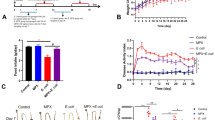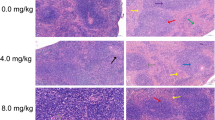Abstract
Dietary glutamine (Gln) or arginine (Arg) supplementation is beneficial for intestinal health; however, whether Gln or Arg may confer protection against Enterotoxigenic Escherichia coli (ETEC) infection is not known. To address this, we used an ETEC-infected murine model to investigate the protective effects of Gln and Arg. Experimentally, we pre-treated mice with designed diet of Gln or Arg supplementation prior to the oral ETEC infection and then assessed mouse mortality and intestinal bacterial burden. We also determined the markers of intestinal innate immunity in treated mice, including secretory IgA response (SIgA), mucins from goblet cells, as well as antimicrobial peptides from Paneth cells. ETEC colonized in mouse small intestine, including duodenum, jejunum, and ileum, and inhibited the mRNA expression of intestinal immune factors, such as polymeric immunoglobulin receptor (pIgR), cryptdin-related sequence 1C (CRS1C), and Reg3γ. We found that dietary Gln or Arg supplementation decreased bacterial colonization and promoted the activation of innate immunity (e.g., the mRNA expression of pIgR, CRS1C, and Reg3γ) in the intestine of ETEC-infected mice. Our results suggest that dietary arginine or glutamine supplementation may inhibit intestinal ETEC infection through intestinal innate immunity.





Similar content being viewed by others
References
Akira S, Uematsu S, Takeuchi O (2006) Pathogen recognition and innate immunity. Cell 124(4):783–801. doi:10.1016/j.cell.2006.02.015
Bevins CL, Salzman NH (2011) Paneth cells, antimicrobial peptides and maintenance of intestinal homeostasis. Nat Rev Microbiol 9(5):356–368. doi:10.1038/nrmicro2546
Fleckenstein JM, Hardwidge PR, Munson GP, Rasko DA, Sommerfelt H, Steinsland H (2010) Molecular mechanisms of enterotoxigenic Escherichia coli infection. Microbes Infect/Inst Pasteur 12(2):89–98. doi:10.1016/j.micinf.2009.10.002
Gao X, Wan F, Mateo K, Callegari E, Wang D, Deng W, Puente J, Li F, Chaussee MS, Finlay BB, Lenardo MJ, Hardwidge PR (2009) Bacterial effector binding to ribosomal protein s3 subverts NF-kappaB function. PLoS Pathog 5(12):e1000708. doi:10.1371/journal.ppat.1000708
Gao X, Wang X, Pham TH, Feuerbacher LA, Lubos ML, Huang M, Olsen R, Mushegian A, Slawson C, Hardwidge PR (2013) NleB, a bacterial effector with glycosyltransferase activity, targets GAPDH function to inhibit NF-kappaB activation. Cell Host Microbe 13(1):87–99. doi:10.1016/j.chom.2012.11.010
Heim G, Sweeney T, O’Shea CJ, Doyle DN, O’Doherty JV (2014) Effect of maternal supplementation with seaweed extracts on growth performance and aspects of gastrointestinal health of newly weaned piglets after challenge with enterotoxigenic Escherichia coli K88. Br J Nutr 112(12):1955–1965. doi:10.1017/S0007114514003171
Kreisberg RB, Harper J, Strauman MC, Marohn M, Clements JD, Nataro JP (2011) Induction of increased permeability of polarized enterocyte monolayers by enterotoxigenic Escherichia coli heat-labile enterotoxin. Am J Trop Med Hyg 84(3):451–455. doi:10.4269/ajtmh.2011.10-0445
Leocadio PC, Antunes MM, Teixeira LG, Leonel AJ, Alvarez-Leite JI, Machado DC, Generoso SV, Cardoso VN, Correia MI (2015) l-Arginine pretreatment reduces intestinal mucositis as induced by 5-FU in mice. Nutr Cancer 67(3):486–493. doi:10.1080/01635581.2015.1004730
Li N, Neu J (2009) Glutamine deprivation alters intestinal tight junctions via a PI3-K/Akt mediated pathway in Caco-2 cells. J Nutr 139(4):710–714. doi:10.3945/jn.108.101485
Loos M, Geens M, Schauvliege S, Gasthuys F, van der Meulen J, Dubreuil JD, Goddeeris BM, Niewold T, Cox E (2012) Role of heat-stable enterotoxins in the induction of early immune responses in piglets after infection with enterotoxigenic Escherichia coli. PLoS One 7(7):e41041. doi:10.1371/journal.pone.0041041
Nakashima R, Kamata Y, Nishikawa Y (2013) Effects of Escherichia coli heat-stable enterotoxin and guanylin on the barrier integrity of intestinal epithelial T84 cells. Vet Immunol Immunopathol 152(1–2):78–81. doi:10.1016/j.vetimm.2012.09.026
Nassour H, Dubreuil JD (2014) Escherichia coli STb enterotoxin dislodges claudin-1 from epithelial tight junctions. PLoS One 9(11):e113273. doi:10.1371/journal.pone.0113273
Ngendahayo Mukiza C, Dubreuil JD (2013) Escherichia coli heat-stable toxin b impairs intestinal epithelial barrier function by altering tight junction proteins. Infect Immun 81(8):2819–2827. doi:10.1128/IAI.00455-13
Ren W, Yin Y, Liu G, Yu X, Li Y, Yang G, Li T, Wu G (2012) Effect of dietary arginine supplementation on reproductive performance of mice with porcine circovirus type 2 infection. Amino Acids 42(6):2089–2094. doi:10.1007/s00726-011-0942-y
Ren W, Li Y, Yu X, Luo W, Liu G, Shao H, Yin Y (2013a) Glutamine modifies immune responses of mice infected with porcine circovirus type 2. Br J Nutr 110(6):1053–1060. doi:10.1017/S0007114512006101
Ren W, Liu S, Chen S, Zhang F, Li N, Yin J, Peng Y, Wu L, Liu G, Yin Y, Wu G (2013b) Dietary l-glutamine supplementation increases Pasteurella multocida burden and the expression of its major virulence factors in mice. Amino Acids 45(4):947–955. doi:10.1007/s00726-013-1551-8
Ren W, Luo W, Wu M, Liu G, Yu X, Fang J, Li T, Yin Y, Wu G (2013c) Dietary l-glutamine supplementation improves pregnancy outcome in mice infected with type-2 porcine circovirus. Amino Acids 45(3):479–488. doi:10.1007/s00726-011-1134-5
Ren W, Zou L, Li N, Wang Y, Liu G, Peng Y, Ding J, Cai L, Yin Y, Wu G (2013d) Dietary arginine supplementation enhances immune responses to inactivated Pasteurella multocida vaccination in mice. Br J Nutr 109(5):867–872. doi:10.1017/S0007114512002681
Ren W, Chen S, Yin J, Duan J, Li T, Liu G, Feng Z, Tan B, Yin Y, Wu G (2014a) Dietary arginine supplementation of mice alters the microbial population and activates intestinal innate immunity. J Nutr 144(6):988–995. doi:10.3945/jn.114.192120
Ren W, Duan J, Yin J, Liu G, Cao Z, Xiong X, Chen S, Li T, Yin Y, Hou Y, Wu G (2014b) Dietary l-glutamine supplementation modulates microbial community and activates innate immunity in the mouse intestine. Amino Acids 46(10):2403–2413. doi:10.1007/s00726-014-1793-0
Ren W, Yin J, Duan J, Liu G, Zhu X, Chen S, Li T, Wang S, Tang Y, Hardwidge PR (2014c) Mouse intestinal innate immune responses altered by enterotoxigenic Escherichia coli (ETEC) infection. Microbes Infect/Inst Pasteur 16(11):954–961. doi:10.1016/j.micinf.2014.09.005
Ren W, Yin J, Wu M, Liu G, Yang G, Xion Y, Su D, Wu L, Li T, Chen S, Duan J, Yin Y, Wu G (2014d) Serum amino acids profile and the beneficial effects of l-arginine or l-glutamine supplementation in dextran sulfate sodium colitis. PLoS One 9(2):e88335. doi:10.1371/journal.pone.0088335
Ren WK, Yin J, Gao W, Chen S, Duan JL, Liu G, Li TJ, Li NZ, Peng YY, Yin YL (2015) Metabolomics study of metabolic variations in enterotoxigenic Escherichia coli-infected piglets. Rsc Adv 5(73):59550–59555. doi:10.1039/c5ra09513a
Ren W, Yin J, Chen S, Duan J, Liu G, Li T, Li N, Peng Y, Tan B, Yin Y (2016a) Proteome analysis for the global proteins in the jejunum tissues of enterotoxigenic Escherichia coli-infected piglets. Sci Rep 6:25640. doi:10.1038/srep25640
Ren W, Wang K, Yin J, Chen S, Liu G, Tan B, Wu G, Bazer FW, Peng Y, Yin Y (2016b) Glutamine-induced secretion of intestinal secretory immunoglobulin A: a mechanistic perspective. Front Immunol 7:503. doi:10.3389/fimmu.2016.00503
Ren W, Yin J, Duan J, Liu G, Tan B, Yang G, Wu G, Bazer FW, Peng Y, Yin Y (2016c) mTORC1 signaling and IL-17 expression: Defining pathways and possible therapeutic targets. Eur J Immunol 46(2):291–299
Ren W, Yin J, Xiao H, Chen S, Liu G, Tan B, Li N, Peng Y, Li T, Zeng B, Li W, Wei H, Yin Z, Wu G, Hardwidge PR, Yin Y (2017a) Intestinal microbiota-derived GABA mediates interleukin-17 expression during enterotoxigenic Escherichia coli infection. Front Immunol 7
Ren W, Liu G, Yin J, Tan B, Wu G, Bazer FW, Peng Y, Yin Y (2017b) Amino-acid transporters in T-cell activation and differentiation. Cell Death Dis 8(3):e2655
Rowe B, Taylor J, Bettelheim KA (1970) An investigation of traveller’s diarrhoea. Lancet 1(7636):1–5
Schroder K, Tschopp J (2010) The inflammasomes. Cell 140(6):821–832. doi:10.1016/j.cell.2010.01.040
Sears CL, Kaper JB (1996) Enteric bacterial toxins: mechanisms of action and linkage to intestinal secretion. Microbiol Rev 60(1):167–215
Takeuchi O, Akira S (2010) Pattern recognition receptors and inflammation. Cell 140(6):805–820. doi:10.1016/j.cell.2010.01.022
Tan B, Xiao H, Xiong X, Wang J, Li G, Yin Y, Huang B, Hou Y, Wu G (2015) l-Arginine improves DNA synthesis in LPS-challenged enterocytes. Frontiers Biosci 20:989–1003
Tang Y, Li F, Tan B, Liu G, Kong X, Hardwidge PR, Yin Y (2014) Enterotoxigenic Escherichia coli infection induces intestinal epithelial cell autophagy. Vet Microbiol 171(1–2):160–164. doi:10.1016/j.vetmic.2014.03.025
Vereecke L, Beyaert R, van Loo G (2011) Enterocyte death and intestinal barrier maintenance in homeostasis and disease. Trends Mol Med 17(10):584–593. doi:10.1016/j.molmed.2011.05.011
Wan F, Weaver A, Gao X, Bern M, Hardwidge PR, Lenardo MJ (2011) IKKbeta phosphorylation regulates RPS3 nuclear translocation and NF-kappaB function during infection with Escherichia coli strain O157:H7. Nat Immunol 12(4):335–343. doi:10.1038/ni.2007
Wang X, Hardwidge PR (2012) Enterotoxigenic Escherichia coli prevents host NF-kappaB activation by targeting IkappaBalpha polyubiquitination. Infect Immun 80(12):4417–4425. doi:10.1128/IAI.00809-12
Wang X, Gao X, Hardwidge PR (2012) Heat-labile enterotoxin-induced activation of NF-kappaB and MAPK pathways in intestinal epithelial cells impacts enterotoxigenic Escherichia coli (ETEC) adherence. Cell Microbiol 14(8):1231–1241. doi:10.1111/j.1462-5822.2012.01793.x
Wang B, Wu Z, Ji Y, Sun K, Dai Z, Wu G (2016) l-Glutamine enhances tight junction integrity by activating CaMK kinase 2-AMP-activated protein kinase signaling in intestinal porcine epithelial cells. J Nutr 146(3):501–508. doi:10.3945/jn.115.224857
Wu L, Liao P, He L, Feng Z, Ren W, Yin J, Duan J, Li T, Yin Y (2015) Dietary l-arginine supplementation protects weanling pigs from deoxynivalenol-induced toxicity. Toxins 7(4):1341–1354. doi:10.3390/toxins7041341
Wu M, Xiao H, Liu G, Chen S, Tan B, Ren W, Bazer FW, Wu G, Yin Y (2016) Glutamine promotes intestinal SIgA secretion through intestinal microbiota and IL-13. Mol Nutr Food Res 60(7):1637–1648. doi:10.1002/mnfr.201600026
Xiao D, Wang Y, Liu G, He J, Qiu W, Hu X, Feng Z, Ran M, Nyachoti CM, Kim SW, Tang Z, Yin Y (2014) Effects of chitosan on intestinal inflammation in weaned pigs challenged by enterotoxigenic Escherichia coli. PLoS One 9(8):e104192. doi:10.1371/journal.pone.0104192
Xiao DF, Ren WK, Bin P, Chen S, Yin J, Gao W, Liu G, Nan Z, Hu XG, He JH (2016) Chitosan lowers body weight through intestinal microbiota and reduces IL-17 expression via mTOR signalling. J Funct Foods 22:166–176. doi:10.1016/j.jff.2016.01.009
Zhang L, Zhang L, Zhan X, Zeng X, Zhou L, Cao G, Chen A, Yang C (2016) Effects of dietary supplementation of probiotic, Clostridium butyricum, on growth performance, immune response, intestinal barrier function, and digestive enzyme activity in broiler chickens challenged with Escherichia coli K88. J Anim Sci Biotechnol 7:3. doi:10.1186/s40104-016-0061-4
Author contributions
GL, WR, and YY conceived the experiment(s); GL, WR, JF, GG, JY, SC, and YP conducted the experiments; GL, WR, NAA, and VD analyzed the results; GL, WR, and CAH prepared the manuscript. All authors reviewed the manuscript.
Author information
Authors and Affiliations
Corresponding authors
Ethics declarations
The protocol for this study was approved by the Committee on the Ethics of Animal Experiments of Institute of Subtropical Agriculture, Chinese Academy of Sciences (Permit Number: 201206-14), and it was conducted out in accordance with the recommendations in the Guide for the Care and Use of Laboratory Animals of Institute of Subtropical Agriculture, Chinese Academy of Sciences.
Funding
This study was in part supported by National key research and development program of China (2016YFD0500504), International Partnership Program of Chinese Academy of Sciences (161343KYSB20160008), the Science and Technology Department of Hunan province (13JJ2034, 2013FJ3011, 2014NK3048, 2014NK4134, and 2014WK2032), the National Natural Science Foundation of China (Nos. 31330075, 31110103909, 31572416, 31402092, 31501965, and 31372326), and Chinese Academy of Sciences visiting professorship for senior international scientists Grant No. 2016VBB007. The authors are grateful to the Deanship of Scientific Research, King Saud University for funding through Vice Deanship of Scientific Research Chairs.
Conflict of interest
The authors declare that they have no conflict of interest.
Additional information
Handling Editors: C.-A. A. Hu, Y. Yin, Y. Hou, G. Wu, Y. Teng.
Rights and permissions
About this article
Cite this article
Liu, G., Ren, W., Fang, J. et al. l-Glutamine and l-arginine protect against enterotoxigenic Escherichia coli infection via intestinal innate immunity in mice. Amino Acids 49, 1945–1954 (2017). https://doi.org/10.1007/s00726-017-2410-9
Received:
Accepted:
Published:
Issue Date:
DOI: https://doi.org/10.1007/s00726-017-2410-9




